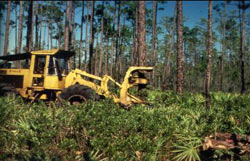Introduction

Welcome to the Watershed Academy's module on forestry best management practices (BMPs) in watersheds. This module, along with similar modules on agriculture and urban management, is about controlling impacts from common land use activities that often affect watersheds, water quality, and the condition of aquatic ecosystems.
This module has been compiled using graphics and information mostly derived from five government sources:
- Forestry Best Management Practices, a poster developed by the USEPA and the American Forest and Paper Association;
- Montana Guide to the Streamside Management Zone Law & Rules, a booklet compiled by MT Dept of State Lands;
- Montana Forestry BMPs, a booklet compiled by MT Dept of Environmental Quality;
- Forest Management for Water Quality, a training course prepared by USDA-Forest Service and USEPA.
- The US Environmental Protection Agency's Non-Point Source Forestry Management Measures, which provide general guidance on management practices suitable for minimizing impacts on US waters.
After completing this module, you should be familiar with the steps commonly involved in planning and carrying out timber harvest and reforestation, and several of the basic ways to reduce or avoid impacts on water resources during these activities. Self-test questions appear at the end of the module's eight sections.
How this module is organized
After a brief introduction, there are eight main topics in this training. These eight topics are covered in sub-presentations accessible from a full-screen "poster" slide that shows common forestry management measures from planning through reforestation. This poster slide serves as a central hub for accessing all the sub-presentations in order just click on each of the eight management practices in the poster to bring up a presentation. Each sub-presentation introduces a general type of forestry measure, discusses its possible impacts, offers guidance on the basic techniques to minimize impacts, and poses interactive review questions. Completing the whole module may require one to two hours.
Click the "Next" arrow at the top of your screen to advance to the next section of this module.
This is one of the 15 required modules in the Watershed Management Certificate Program.
Section 1 of 38
![[logo] US EPA](https://www.epa.gov/epafiles/images/logo_epaseal.gif)